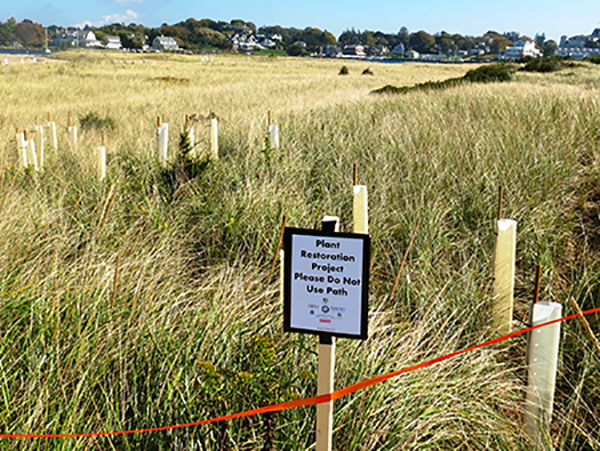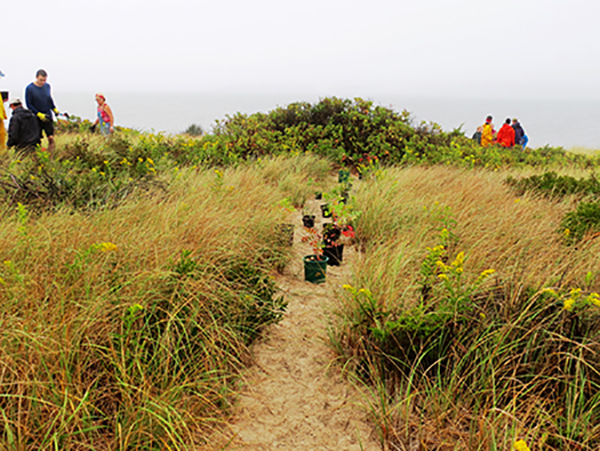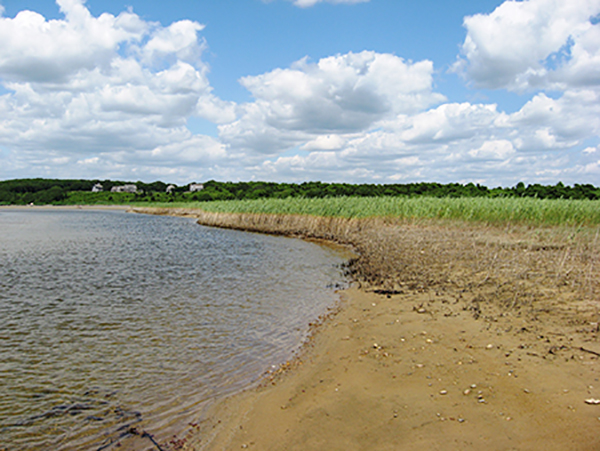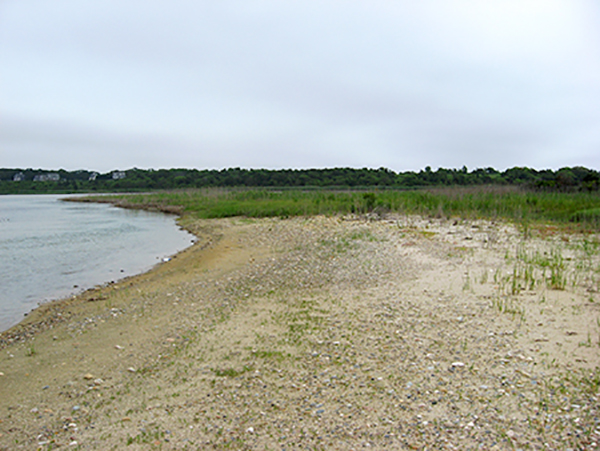
RI Coastal Resources Management Council
...to preserve, protect, develop, and restore coastal resources for all Rhode Islanders

...to preserve, protect, develop, and restore coastal resources for all Rhode Islanders
CRMC funds 11 habitat restoration projects
March 22, 2017, WAKEFIELD – The R.I. Coastal Resources Management Council (CRMC) has awarded funding for eleven habitat restoration projects, through its RI Coastal and Estuarine Habitat Restoration Trust Fund (CEHRTF).
The Council approved the funding at the February 28 semi-monthly meeting in Providence. Projects approved for funding include a salt marsh restoration and enhancement project, a statewide salt marsh monitoring effort, eelgrass monitoring and assessment, two coastal resiliency projects, construction of a fishway, an urban habitat restoration pilot project, and evaluation of strategies to facilitate salt marsh migration.
As with the previous two years, in its request for proposals the CRMC put special emphasis on projects that would enhance the resiliency of Rhode Island’s coastal habitats to climate change and sea level rise. One of the funded projects, improving coastal resiliency at Longmeadow coastal access site, exemplifies these goals. Through the Trust Fund, the R.I. Department of Environmental Management was awarded $4,225 to restrict vehicular access over sensitive coastal habitats that have been damaged by traffic. In addition, RIDEM will remove 1,000 square feet of asphalt and repair and revegetate a dune to address the severe coastal and erosion that has occurred at the site.
The largest award this year – $64,000 – was awarded to The Nature Conservancy for improving fish passage at Bradford Dam in Westerly and Hopkinton. This project, which was awarded funding in 2016 for the removal of the dam and construction of a nature-like step-pool in its place, will receive partial funding associated with increased project costs due to project design changes and construction.
DEM’s Division of Fish & Wildlife was awarded $40,000 for the construction of the Factory Brook Dam Fishway in South Kingstown. A fish ladder will be constructed at a small, privately-owned dam for the purpose of restoring river herring to Factory Brook and Factory Pond. The existing five-foot-high dam prevents herring passage to spawning and nursery habitat in the 30-acre pond and one mile of stream habitat. Fish passage would potentially result in tens of thousands of returning river herring annually, which will enhance freshwater and marine ecosystems.
Narragansett Bay National Estuarine Research Reserve (NBNERR) was awarded $20,424 toward the evaluation of strategies to facilitate salt marsh migration at Sheep Pen Marsh on Prudence Island. It is estimated that Rhode Island has lost 53 percent of its marsh area since 1832 and researchers fear additional losses may be accelerating due to sea level rise. Ideally, marshes will migrate landward with rising seas, but current research shows that some types of upland vegetation can prevent migration. NBNERR will create a field project to determine how the removal of three different types of upland vegetation affects marsh migration.
NBNERR was also awarded $19,427 toward salt marsh monitoring in Rhode Island at multiple salt marshes across the state. The project is designed to improve understanding of marsh vulnerability to sea level rise at a broad scale that can be used to guide restoration and adaptation project funding. The monitoring will occur over a small network of marshes and answer specific questions about marsh condition and response to sea level rise.
The CRMC also awarded $19,242 to DEM’s Division of Fish & Wildlife for the Sapowet Creek salt marsh adaptation and coastal restoration in Tiverton. DEM plans to restore 21 acres of cultivated agricultural field to coastal grasslands by planting native warm season grasses and forbs and managing invasive species in the surrounding buffer. Improvements will also be made to the adjacent marsh to restore natural drainage patterns and remove ponding that has resulted from sea level rise.
The University of Rhode Island’s Environmental Data Center (EDC) received $17,982 for eelgrass Tier 1 accuracy assessment and monitoring. Eelgrass and widgeon grass are the main species of seagrasses found in Rhode Island coastal waters. Mapping the distribution and extent of seagrasses is a critical first step in understanding, managing, and protecting these shallow-subtidal estuarine habitats. The extent of seagrasses, however, is sensitive to environmental conditions like water quality, storms, disease, and coastal development. The EDC will refine eelgrass maps created in 2016 from aerial photography by mapping eelgrass beds in the field and comparing the two datasets.
Watch Hill Fire District and Watch Hill Conservancy were awarded partial funding of $15,000 for coastal barrier protection and plant community restoration in the Napatree Point Conservation Area in Watch Hill. This project will expand previous efforts to restore native plants on Napatree by adding species to benefit pollinator species and managing invasive species.
The Council awarded $15,000 in partial funding to URI for the restoration of diamondback terrapin nesting habitat on the Potowomut River in East Greenwich. During the spring and summers of 2015-2016, URI and Rocky Hill School faculty and students documented a previously unknown population of diamondback terrapins living in Potowomut River and nesting and using the beach and salt marsh habitat along the river. This is only the second documented significant population of the turtles in the state. This project will restore and improve habitat for the population of terrapins that uses the location for nesting and overwintering of hatchlings. The funding will go toward planning for this project, data collection, obtaining necessary permits, terrapin monitoring, and developing a long-term monitoring program for the population post-restoration.
A total of $5,000 was awarded to the Blackstone Parks Conservancy for the revegetation and slope stabilization in Blackstone Park Conservation District in Providence. The BPC plans to continue previous work to stabilize the slope in the area, which will stem erosion and create favorable conditions for plant survival. Native plants will be added to the 4-acre restoration site, and fences will be installed to protect the new plants.
The Woonasquatucket River Watershed Council received $4,700 in Trust Fund monies for an urban habitat restoration pilot project along the Woonasquatucket River on Promenade and Kinsley Avenue in Providence. This project will continue work being done by the WRWC and the Providence Parks Department to manage invasive plants in the area. Before beginning the project, invasive plants were strangling and killing many of the native trees and shrubs on the site. Funds will go toward the purchase of native plants to increase habitat in the very urbanized stretch of river.
Habitat restoration projects are funded through the RI Coastal and Estuarine Habitat Restoration Trust Fund and are selected from recommendations by the fund’s Technical Advisory Committee. Program funds come from the state’s Oil Spill Prevention Administration and Response Act (OSPAR), established by the legislature following the 1996 North Cape oil spill. Each year, the CEHRTF advisory committee, with approval of the CRMC allocates $225,000 from the OSPAR account to habitat restoration projects throughout the state.
“The CRMC is pleased to support this year’s suite of habitat restoration and coastal adaptation projects, as well as the variety of statewide and focused planning and research efforts,” said CRMC Executive Director Grover Fugate. “Rhode Island must study and then act to protect and preserve its fragile and valuable coastal habitats, and these projects will serve to inform the state for future restoration projects.”
To date and including this year, the Trust Fund has awarded $3.25 million for 121 projects, which have leveraged more than $23 million in matching funds. In its 14 years, the Trust Fund has helped to restore over 300 acres of coastal and estuarine habitat. Photos of the projects are available upon request.


The CRMC awarded $15,000 for coastal barrier protection and plant community restoration at Napatree Point Conservation Area in Watch Hill. (Photos: Watch Hill Conservancy)


Funded in 2015, The Nature Conservancy received $9,300 to restore native plants within Goosewing Beach complex in Little Compton, and manage the invasive Phragmites australis. (Photos: TNC)